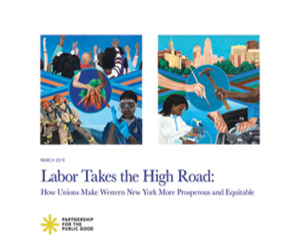In March 2019, the Partnership for the Public Good released a report entitled Labor Takes the High Road: How Unions Make Western New York More Prosperous and Equitable. With support from WDI, this collaboration project between the Partnership for the Public Good, the Western New York Area Labor Federation, and the Cornell School of Industrial Relations discusses the positive impact of labor unions on Western New York’s economy and on society as a whole. The report delves into the myriad ways that labor unions float all boats; their activity results in higher wages and better benefits for a region’s workers. Not only do unions make workplaces more safe, healthy, and fair, but their impact reaches far beyond individual workplaces. The report notes that “through community service, civic engagement, worker assistance, workforce development, and public policy advocacy, union members build the ‘high road’ that makes the entire community more prosperous, united, and inclusive.”
Since 1973, the rate of union membership in America has significantly decreased and economic inequality has increased. This is the result of the changing types of available work and “right-to-work” laws and workplace policies that make it difficult for employees to organize. Over the last several decades, the nation has lost jobs in previously unionized sectors such as manufacturing, and has instead gained jobs in non-unionized sectors such as retail. The Buffalo-Niagara region offers a dramatic example of the consequences of this nationwide shift. In 1986 roughly 27% of the region’s private sector workers held union jobs. Today only 11% workers of private sector workers in the region are in unions. With the reduction in unions jobs went a reduction in middle wage jobs and benefits. Today, a staggering one-third of the Buffalo-Niagara workforce works in an occupation with a median wage of less than $15 per hour.
According to the report, “states with higher levels of unionization have lower poverty levels, higher average incomes, lower workplace deaths, higher educational outcomes, and higher pension and health insurance coverage, even for workers not in unions.” As unions bargain for higher wages and better benefits at one employer, non-union employers tend to raise their wages and offer better benefits to compete and discourage unionization at their business. Unions also advocate for higher wages for all workers through policies like minimum wage and living wage laws.
Unions also have a significant impact on the community through community service, worker assistance programs, voting, and workforce development programs as well. Union members have donated their time, expertise, and donations to hundreds of causes in Western New York. As George Harrison, Principal Office of Teamsters Local 499, says “We don’t consider ourselves just a labor organization; we’re also a community outreach organization.”
Finally, labor organizations in Western New York also have a long track record of fighting for civil rights, environmental protections, public health, public education, and responsible economic development. The region’s unions have helped support recent policy advances on issues including: living wages, minimum wage increases, first source hiring policies, gender equity, safe patient handling, safe staffing for quality care, “just transitions” for workers and communities affected by power plant closings, and reforms for wasteful economic development policies.
The findings in this report exemplify the critical role labor unions play in creating a sustainable and equitable society and economy, and truly raising all boats. The full report can be found here.
